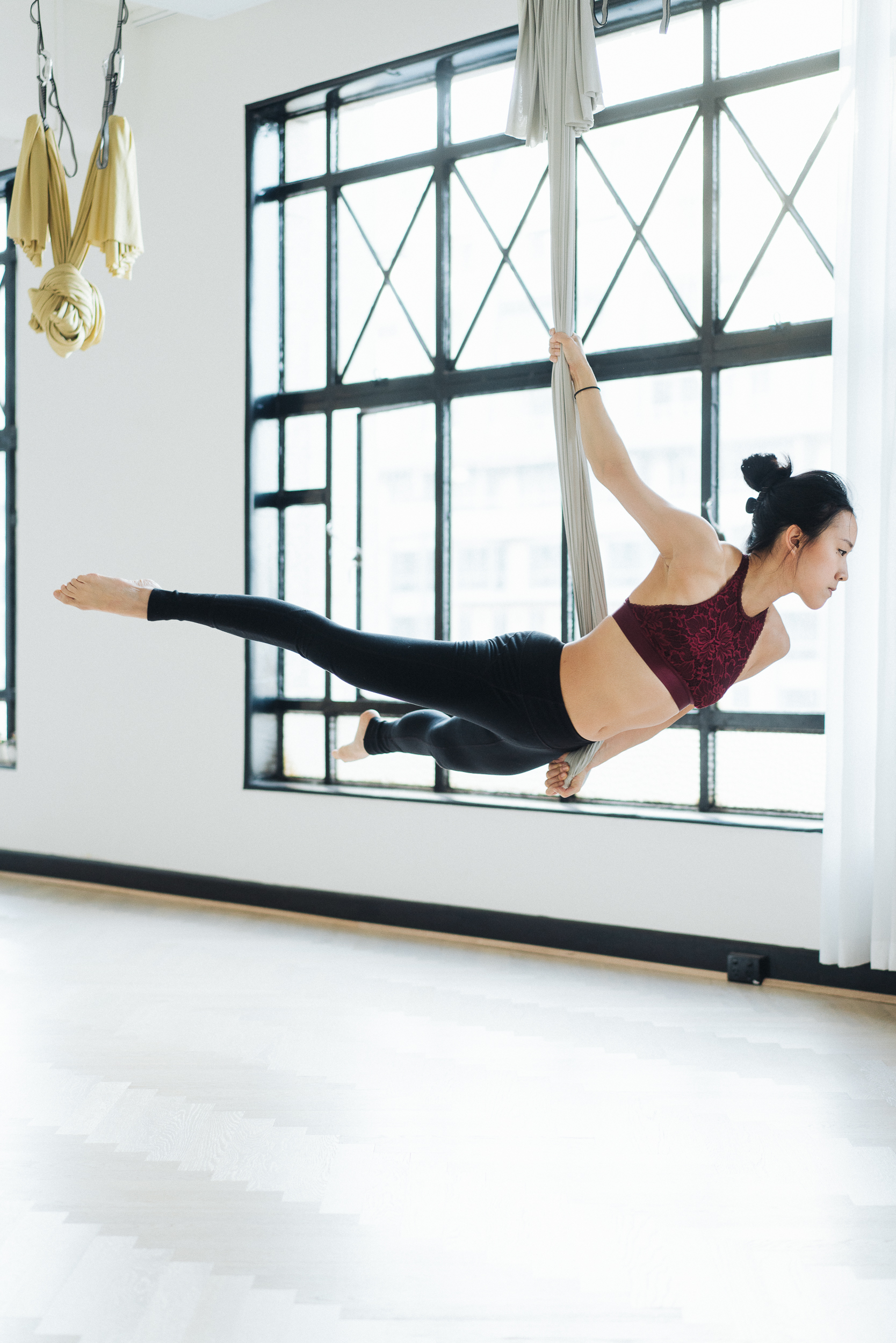“Engaging Your Core” – More than Just Your Abs
In conjunction with the introduction of new class styles, “Aerial Core” (starting Sept 24th, 2018) and “Alignment Flow”, here’s a little preview of what to expect!
Engaging Your Core
More Than Just Your Abs
Author: Kelly Foong | Editor&Photographer: Jamie Zhou | Demo: Winnie Au
We hear the common cue to “engage your core” not only in yoga classes, but especially at the gym, with many exercises targeted at helping you “tone your belly”. However, the core is more than just your abs! There is a difference between outer strength and a subtler, but stronger, inner strength.
Pike exercise that teaches you how to move from your pelvis with stability
Have you ever noticed in class when someone looks like a body builder but is struggling with arm balances, whilst someone who appears to be small with no bulging muscles looks calm and serene in “chaturanga dandasana”? That’s why having a 6-pack does not necessarily translate to being able to do functional body weight movements.
Importance of Having a Strong Core
Having a strong core benefits not only our movement practices but also makes a big difference in our daily life. Everything from walking, sitting, playing sports and yoga, become more sustainable, effortless (or rather appears more effortless) and most importantly, safer, with a strong core. A strong core helps us stabilise our spine.
Try keeping your body as one piece as you move. Keeping the knees down allows you to play with the movement whilst taking some of the weight off.
Level up! Move as one plank of wood - the knees off increases the difficulty and instability.
In a previous blog post, we mentioned how lower back pain can be caused by having tight hamstrings (read more here to find out 3 ways you can release tight hamstrings). Another reason why you may experience lower back pain, especially if your lower back feels extra sensitive after exercising, is a weak core. If your core is weak, you are not supporting your spine during movements, which can cause compensation in other body parts such as dumping into your lower back.
Not Just Your Abs… So What is It?
Just sucking your belly in or “pulling your navel to your spine” is only one piece of the puzzle to your core. The core is something that wraps around the whole body and to tap into your real core strength, we need to activate the deep frontal line, which allows us to keep the outer body soft and flexible whilst manipulating the spine – either to keep it a neutral position, flexed or extended. Or… if you’re familiar with more yogi talk: uddhiyana bandha (abdominal lock) and mula bandha (pelvic floor lock) also ties in with this but that’s a whole other article in and of itself for another day…
How To Engage Your Real Core
1. Engage your deep frontal line: Deep frontal what? Think of a line being drawn along the centre of your body from your feet all the way up to the crown of your head. Sometimes you might hear cues such as “draw to the mid-line” in classes. In order to stabilise and move with efficiency, we need to draw everything back to the mid-line instead of energy dissipating outwards.
2. Press and Rebound Effect: In any pose, think of your foundation – what is touching the ground? From there, use the foundation points to actively push down and then feel the rebound energy that gives you more strength to pull everything else in and up to the mid-line. Think in opposites! If you would like a detailed example using chaturanga dandasana, click here!
Plank pose - legs suspended in the air optional!
Mini At-Home Test – Are You Engaging Your Real Core?
Start in a plank, shoulders stacked above the wrists and heels stacked about the balls of the feet (doing it suspended is optional).
Foundation (the parts touching the ground): hands and feet
Outer strength: Doing nothing except the base form of setting up; Just hanging in the joints; feels heavy
Inner strength (using deep frontal line): Actively push the hands and the feet down whilst drawing your belly in and up, pushing the back of your thighs up to the ceiling, rounding into your upper back, pushing the heels to the back of the room whilst reaching the crown of the head forward, squeeze the inner thighs to the mid-line, ground down through the index and thumb mounds whilst drawing energy up the inner line of your arm to the mid-line… a mouthful!
The Takeaway
Next time you’re practising in class or at home, try incorporating these ideas into every asana (yoga pose) and transition. As you may have noticed, it can be a mouthful of instructions so sometimes in a faster paced class, the teacher may only briefly say engage your core when they mean the above! But now you know what they really mean and can engage your real core (the deep frontal line)!
----
To help you understand how to use your real core muscles, we are introducing two new styles (starting Sept 24th, 2018) to Little Mandarin Yoga – Aerial Core and Alignment Flow – which gives us more time to explore and breakdown these ideas in every posture to advance your practice to the next level safely and effectively. You can then take these teachings into an Aerial Flow or Vinyasa Flow class. Knowledge is empowering – let’s explore more together! Book a class here.










